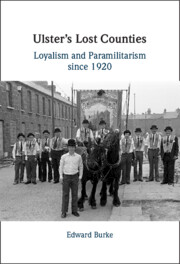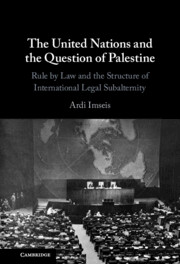85 results
Chapter 2 - Revolver in Hand, Lining the Ditches
-
- Book:
- Ulster's Lost Counties
- Published online:
- 18 April 2024
- Print publication:
- 25 April 2024, pp 31-94
-
- Chapter
- Export citation
Chapter 1 - Introduction
-
- Book:
- Ulster's Lost Counties
- Published online:
- 18 April 2024
- Print publication:
- 25 April 2024, pp 1-30
-
- Chapter
- Export citation
Chapter 4 - A Toothless Hound of Ulster?
-
- Book:
- Ulster's Lost Counties
- Published online:
- 18 April 2024
- Print publication:
- 25 April 2024, pp 150-184
-
- Chapter
- Export citation
Chapter 5 - The Last Ditch
-
- Book:
- Ulster's Lost Counties
- Published online:
- 18 April 2024
- Print publication:
- 25 April 2024, pp 185-237
-
- Chapter
- Export citation
Chapter 7 - Conclusion
-
- Book:
- Ulster's Lost Counties
- Published online:
- 18 April 2024
- Print publication:
- 25 April 2024, pp 293-303
-
- Chapter
- Export citation
Chapter 3 - Closing the Gates
-
- Book:
- Ulster's Lost Counties
- Published online:
- 18 April 2024
- Print publication:
- 25 April 2024, pp 95-149
-
- Chapter
- Export citation
Chapter 6 - A Suspect Population
-
- Book:
- Ulster's Lost Counties
- Published online:
- 18 April 2024
- Print publication:
- 25 April 2024, pp 238-292
-
- Chapter
- Export citation

Ulster's Lost Counties
- Loyalism and Paramilitarism since 1920
-
- Published online:
- 18 April 2024
- Print publication:
- 25 April 2024
The Postcolonial Uncanny in “Toba Tek Singh”
-
- Journal:
- Cambridge Journal of Postcolonial Literary Inquiry / Volume 11 / Issue 1 / January 2024
- Published online by Cambridge University Press:
- 04 March 2024, pp. 66-73
-
- Article
-
- You have access
- Open access
- HTML
- Export citation
The Effect of Clay Dispersion on the Sorption of Acetonitrile
-
- Journal:
- Clays and Clay Minerals / Volume 40 / Issue 3 / June 1992
- Published online by Cambridge University Press:
- 28 February 2024, pp. 355-358
-
- Article
- Export citation
PARTITION OF LARGE SUBSETS OF SEMIGROUPS
- Part of
-
- Journal:
- The Journal of Symbolic Logic , First View
- Published online by Cambridge University Press:
- 03 January 2024, pp. 1-6
-
- Article
- Export citation
Epilogue
-
- Book:
- Mandatory Madness
- Published online:
- 16 November 2023
- Print publication:
- 30 November 2023, pp 305-314
-
- Chapter
- Export citation
3 - 1947: The UN Plan of Partition for Palestine
-
- Book:
- The United Nations and the Question of Palestine
- Published online:
- 16 November 2023
- Print publication:
- 30 November 2023, pp 52-109
-
- Chapter
- Export citation

The United Nations and the Question of Palestine
- Rule by Law and the Structure of International Legal Subalternity
-
- Published online:
- 16 November 2023
- Print publication:
- 30 November 2023
11 - The Indian Subcontinent: From Raj to Partition
- from Part I - Imperial and Postcolonial Settings
-
-
- Book:
- The Cambridge History of Nationhood and Nationalism
- Published online:
- 08 November 2023
- Print publication:
- 09 November 2023, pp 233-256
-
- Chapter
- Export citation
PARTITIONS OF NATURAL NUMBERS AND THEIR WEIGHTED REPRESENTATION FUNCTIONS
- Part of
-
- Journal:
- Bulletin of the Australian Mathematical Society , First View
- Published online by Cambridge University Press:
- 27 October 2023, pp. 1-7
-
- Article
- Export citation
Region, religion, and locality: revisiting Punjab politics and the Unionist Party, 1923–1947
-
- Journal:
- Journal of the Royal Asiatic Society / Volume 33 / Issue 4 / October 2023
- Published online by Cambridge University Press:
- 11 July 2023, pp. 917-931
- Print publication:
- October 2023
-
- Article
- Export citation
Conclusion
-
- Book:
- Conflict, Diaspora, and Empire
- Published online:
- 15 June 2023
- Print publication:
- 29 June 2023, pp 273-283
-
- Chapter
- Export citation
3 - The Limits of Partition
- from Part I - Human Rights and Democracy in Deeply Divided Places
-
- Book:
- Collective Equality
- Published online:
- 20 April 2023
- Print publication:
- 27 April 2023, pp 73-99
-
- Chapter
- Export citation
Chapter 15 - Salman Rushdie and Diasporic Identities
- from Part III - Historical and Cultural Contexts
-
-
- Book:
- Salman Rushdie in Context
- Published online:
- 23 March 2023
- Print publication:
- 30 March 2023, pp 193-204
-
- Chapter
- Export citation






















